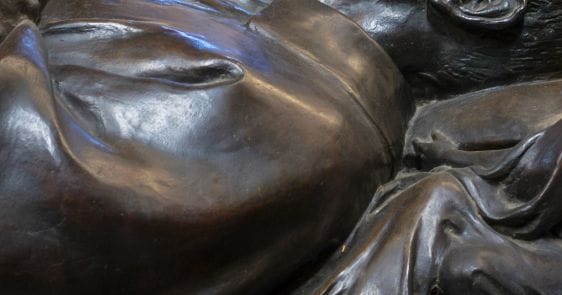Comparing Brass and Bronze
Comparing brass and bronze:
A designer’s guide
Brass, bronze, and architectural bronze – the terms are often used interchangeably, yet each describes a distinct material with its own character.
For designers specifying finishes, the differences can feel subtle, even confusing.
This guide sets out the essentials: what separates brass from bronze, why ‘architectural bronze’ is unique, and how each material performs in high-end applications.
One family, three materials
Brass, standard bronze and architectural bronze are all part of the copper alloy family, but their compositions differ.
• Brass is an alloy of copper and zinc
• Standard bronze is an alloy of copper and tin
• Architectural 385 bronze is technically a brass alloy, made from copper & zinc but formulated for better structural strength
At Renaissance, we use solid 385 architectural bronze for all of our products. As a brass alloy, it offers the warm golden look of brass with superior strength and structural integrity.
How do brass and bronze differ?
Although brass, standard bronze and architectural bronze are very similar – and can look identical – they are not the same. Each material has inherent properties that make it more suited to certain applications:
| Brass | Brass | Standard Bronze | 385 Bronze |
|---|---|---|---|
| Composition | Copper & Zinc 67% copper, 33% zinc | Copper & Tin 88% copper, 12% tin | Copper & Zinc 58% copper, 40% zinc + trace elements |
| Color | Yellow-gold | Golden brown | Yellow-gold |
| Patina | Often patchy, typically green/gray (Verdigris) | Develops more evenly, rich chestnut brown | Develops more evenly, rich chestnut brown |
| Properties | Excellent corrosion resistance Ductile and very machinable Softer than bronze, more prone to wear | Extreme corrosion resistance Ductile and very machinable Harder & stronger than brass | Extreme corrosion resistance Ductile and very machinable Superior hardness & structural strength |
| Applications | Plumbing fixtures incl. faucet bodies, bath & shower hardware Electrical components Internal lock mechanisms Decorative hardware (drawer pulls, door knobs etc) | Sculptures, Mechanical components, (bearings, gears etc) Marine hardware | Architectural elements (building facades, windows and doors,hardware, enclosure systems) |
Solid vs Plated:
The importance of material integrity
When selecting bronze or brass fixtures, it is crucial to understand the difference between solid metal and plated products.
Many systems marketed as ‘brass’ are actually made from brass-plated steel. They may initially look appealing at first, but are more prone to wear, especially in environments with high humidity.
Solid brass systems are available, but because brass is relatively soft, they require thicker, heavier frames, and are more susceptible to damage.
Architectural bronze offers the golden look of brass, with far greater structural integrity, enabling narrow sightlines and elegant forms that don’t compromise on performance.
Harmonizing bronze and brass
Given their close relationship, architectural bronze and brass naturally complement one another in high-end design. In bathroom environments, for instance, it is common to see bronze shower doors paired with brass faucets, hardware, and drawer pulls. Provided that fixtures are sourced from luxury suppliers using brass or architectural bronze alloys, the materials will match in tone, and patina similarly.

Brass patina
Brass patina often shows up as verdigris – grayish or even turquoise green mottling. This is often regarded as undesirable, and is kept at bay with the use of proprietary brass cleaners. Factory-applied lacquers may also be used to keep brass patina bright and golden.

Bronze patina
Bronze (including the brass we refer to as architectural bronze) undergoes a slower and more uniform patina process, darkening the metal’s golden tones to a rich, warm brown. Bronze patina is often seen as a valuable characteristic, lending an air of authenticity and character.
At Renaissance Genuine Solid Bronze, we can control the patina process to suit your desired aesthetic, producing specific color variations including classic charcoal or contemporary slate gray. Even when aged, architectural bronze elements will still pair beautifully with brass, since they share the same tones. Natural bronze can also be protected with lacquers to prevent patina formation and maintain a ‘new’ appearance.
Be inspired by bronze
Discover the unmatched beauty of bronze for yourself –
book a Renaissance product demo today.
Frequently Asked Questions
No, brass and bronze are not the same. Both are copper alloys, but brass combines copper with zinc, while bronze is made primarily from copper and tin. This difference affects color, durability, and use. Brass has a warmer, golden tone often used in decorative accents, while bronze offers deeper hues and greater corrosion resistance.
Brass usually has a bright, golden-yellow appearance, while bronze carries a darker, reddish-brown tone. Over time, bronze develops a natural patina – a protective layer that deepens its character and color – whereas brass tends to stay shinier when polished.
Yes, bronze is stronger and more durable than brass. Its higher tin content gives it greater tensile strength and resistance to corrosion, which is why it’s often used in demanding architectural applications. Solid bronze frames maintain structural integrity in all climates, providing lasting stability and beauty where brass might tarnish or weaken over time.
Brass and bronze can be used together, but care is needed in how they’re combined. Because they’re both copper alloys, they share similar tones and can complement one another in a cohesive design. When used thoughtfully, the two metals can create warm, layered contrasts that elevate architectural detail.
Architectural bronze differs from standard bronze in its formulation and performance. Made primarily from copper and zinc, architectural bronze offers greater strength and consistency in color, making it ideal for precision-crafted windows, doors, and enclosures. Renaissance’s products are made from solid architectural bronze, ensuring authentic patina and exceptional durability…